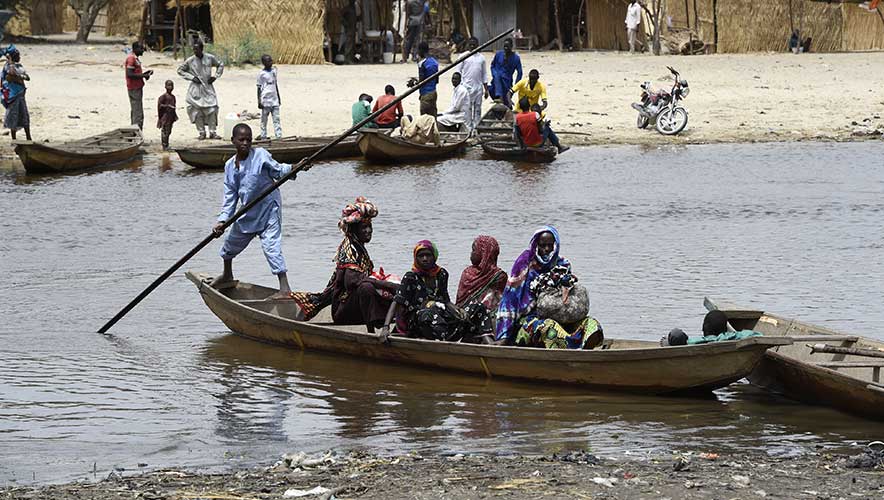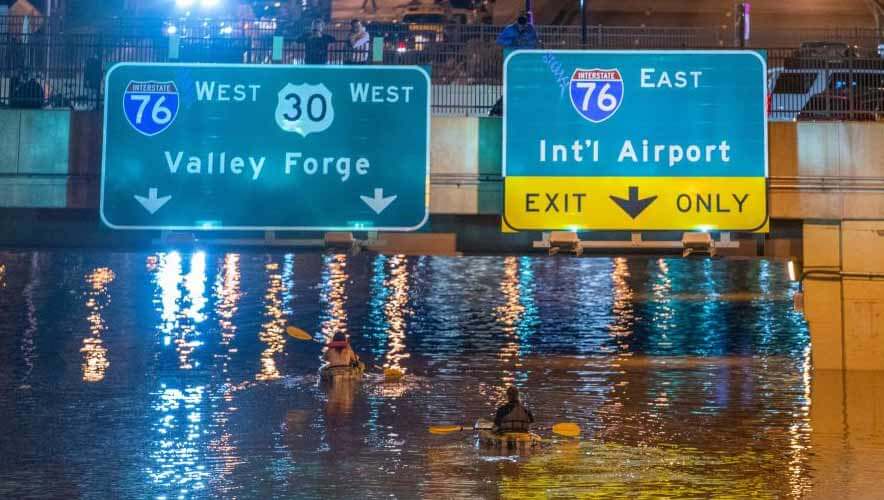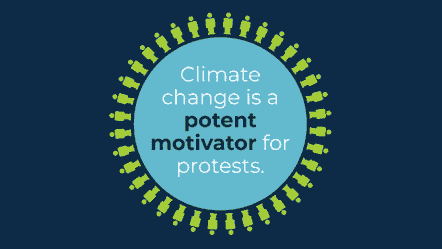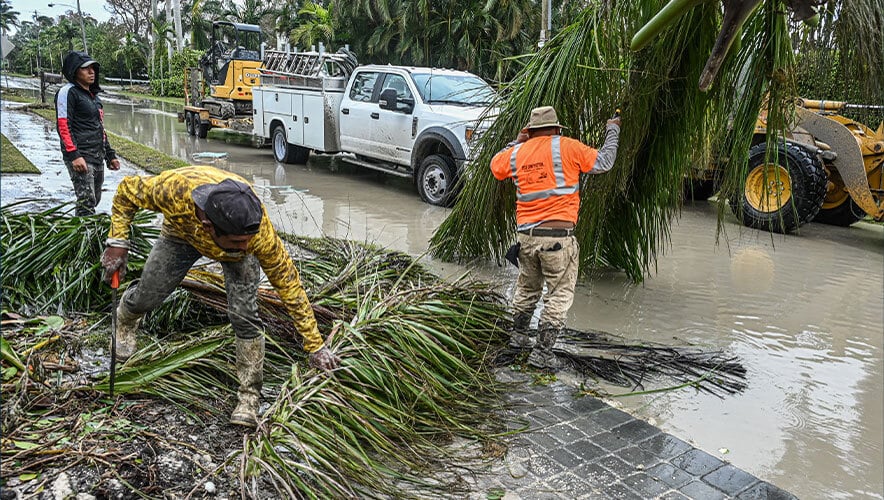How Climate and Security Are Connected
The built world is heavily reliant on the stability and predictability of the climate. From agriculture to infrastructure planning, understanding factors such as where it will rain, how much it will rain, and when it will rain is critical to the functioning of our societies. But climate change is now increasingly disrupting such norms.
According to a 2020 study conducted by McKinsey, “the economic cost of climate-induced hazards is expected to rise dramatically over the next several decades. The research indicates that the value at stake could increase from roughly 2 percent of global GDP to more than 4 percent by 2050.”
The insurance industry has long been a barometer of risk and is now being forced to re-evaluate its business models and respond to the new normal. In the face of rising costs, some insurers are passing on the burden to policyholders while others are abandoning specific geographic areas that have become too risky to insure. This shift in the insurance landscape is a strong indicator that the impacts of climate change are not merely a future threat—it’s a current danger and needs to be fully factored into the business resilience equation.
While catastrophic natural disasters have direct and overt impacts, such events often trigger a cascade of second or third order impacts which manifest in ways that are hard to predict. For example, extreme weather events—including hurricanes, floods, wildfires, and prolonged droughts—have the potential to disrupt food and water supplies and other critical supply chains. In turn, these impacts could exacerbate the conditions for civil instability or lead to cross-border conflict over vital resources.
As a security risk professional, you may still doubt the relevance of climate change to your role, but it’s important to understand that climate threats are not limited to the natural world and can propagate consequences for security stability at multiple levels—from geopolitics and national security down to security at operational levels. With climate change, everything is connected.
Geopolitics
Developments in the Arctic are a clear and early demonstration of how climate change can shape geopolitical relations. Arctic warming is having a diminishing effect upon sea ice which has begun to open access to new resources and shipping routes, leading to a scramble among nations and industry players to secure a foothold in the area. This race for control has sparked tensions among the Arctic states, including Russia, Canada, and the United States, as well as non-Arctic nations like China, which are looking to exert their influence in the region. With the competition intensifying, the risk of military escalation in the Arctic is also rising.
National Security
The implications of climate change on national security are multifaceted and far-reaching. One of the primary concerns is the resilience of defense installations and infrastructure in the face of increasingly severe weather events. A notable example of this occurred in 2018, when Hurricane Michael hit Florida and caused more than $1 billion in damage to F-22 Raptor stealth fighters at Tyndall Air Force Base. Similarly, the United States Navy at Naval Station Norfolk, a strategic military facility in Virginia, is actively working to address the impact of sea level rise, including tidal flooding, increased storm surge, and land loss.
Governments worldwide are also increasingly calling upon military support to deal with civil emergencies arising from the impacts of climate change. Such commitments over the longer term could disrupt overseas force rotations and divert militaries from achieving their principal deterrent and warfighting objectives.
It has been shown that climate has the potential to exacerbate conditions that lead to civil instability or armed conflict. This has been seen in recent history, such as in the case of the Egyptian revolution of 2011, where a drought-induced wheat shortage contributed to significant economic and social unrest, ultimately leading to a major civil uprising. Additionally, in Syria, a prolonged period of drought that resulted in the collapse of the agriculture sector, economic failure, and displacement of population has been documented as a key factor in the onset of the civil war in 2011. Extreme climatic events can act as a catalyst for conflict.
Terrorism
Recent studies have established a correlation between climate change and terrorism. One such study conducted at the University of Maryland examined the potential indirect effects of climate change on terrorism. The research found that climate change serves as a destabilizing factor, providing an ideal environment for extremist organizations to thrive. Additionally, the study determined that climate change can exacerbate the underlying conditions that contribute to the development of terrorism, such as the "root causes" of terrorism.
Root causes of terrorism have historically included economic conditions such as poverty, unemployment, and economic inequality. But climate change-triggered factors can create or worsen conditions that are conducive for both radicalization and exploitation. For example, the terrorist organization Islamic State exploited water shortages in Iraq and took control of dams and other water infrastructure to impose its will on communities. Furthermore, climate change can multiply the drivers of radicalization that facilitate the emergence of terrorism, including push, pull, and personal factors. Lastly, the study found that climate change can exacerbate the number of enabling factors that can lead to an increase in political violence—including acts of terrorism—such as political instability.
A similar study by major European thinktank Adelphi in collaboration with the German Foreign Office found numerous examples where climate change had contributed to conditions for terrorism, namely Boko Haram in the Lake Chad basin, Islamic State in Syria, and organized crime groups in Guatemala.
In climate change, there are always vicious cycles. For instance, in the Arctic, the melting of sea ice has a compounding effect—the exposed water absorbs more heat, leading to further melting. Guatemala is seeing a similar vicious cycle. Criminal groups are profiting from illegal mining and the deforestation of rainforests. These activities release large amounts of greenhouse gases and destroy natural carbon sinks that help regulate the climate. Guatemala is already vulnerable to natural disasters, such as floods, droughts, and hurricanes, but the criminal groups’ actions make it worse. Additionally, their activities fuel violence, human rights violations, and insecurity, which displace vulnerable populations. The very conditions that enable these criminal enterprises to thrive are being perpetuated by their own actions, in a perverse and self-defeating cycle that proves disastrous for people and cultures in Guatemala and nearby countries.
Crime
As average temperatures continue to break records, research has shown a correlation between rising temperatures and increased crime rates. Studies have demonstrated that violent crimes such as homicides, sex offenses, and assaults are more likely to occur during periods of high temperatures.
One study conducted in seven American cities found that for every 5-degree Celsius (9-degree Fahrenheit) increase in daily mean temperature between 2007 and 2017, there was a 4.5 percent increase in reported sex offenses within the subsequent eight days. Moreover, increased heat levels don’t just affect physical crime rates—according to a study by researchers at the Potsdam Institute for Climate Impact Research, online hate speech on Twitter was 22 percent higher on extremely hot days than on milder weather days, which saw the lowest levels of online hate speech.
Given the correlation between high temperatures and crime, it is likely that this trend will continue and potentially worsen in the future because of climate change.
Climate Activism
Unlike any instance of social activism in the past, climate change has the demonstrated power to mobilise and unite people across demographics and global geography.
To date, most contemporary climate action groups profess a commitment to non-violent civil disobedience; however, the possibility of changing tactics and threat escalation exists, particularly as climate activism becomes exacerbated by a perceived slow or disingenuous response by corporations and governments. Moreover, the sheer number of activists involved in climate action is unprecedented (when compared to other protest issues over the last four decades). The Carnegie Endowment for International Peace maintains a Climate Protest Tracker that identifies episodes of mass activism related to climate policy around the world. The tracker shows that there were dozens of major climate protests in 150 countries in 2022. On a probabilistic basis, this raises the likelihood of either unstable individuals or extremist groups using violence under the guise of climate activism.
A recent example of an escalation in activist tactics is that of the Guacamaya hacking group who conducted a string of cyberattacks against mining and oil companies with operations in Latin America in 2022. These attacks disrupted operations, exposed sensitive data, and damaged reputations. For many, this campaign flew under the radar, but it serves as an indicator of the threat that activists may pose should they resort to more sophisticated and hostile forms of activism in the future—beyond the attention-grabbing stunts of today.
Energy Transition Risks to the Extractive Industries
Initiatives by the international community to reach carbon reduction targets create unique risks in themselves. For example, the energy transition will require a vast amount of critical minerals such as copper, which is essential for low-carbon technologies like solar photovoltaic plants, wind farms, and electric vehicles.
Mining companies that are at the downstream end of energy transition face several risks associated with extracting copper and other energy transition metals. These include establishing new operations in remote, unfamiliar, and potentially high-risk settings; environmental risks such as land disturbance, water pollution, and greenhouse gas emissions; social risks such as conflicts with local communities, human rights violations, and cultural heritage impacts; and governance risks such as regulatory uncertainty, corruption, and geopolitical instability.
Mining companies will need to manage all these risks in concert with a massive uptick in operations and changing global footprint, all the while maintaining compliance with strict environment and social governance requirements. Undoubtedly, there will be knock-on impacts to contractors and industries that support the extractive industries.
Business Resilience
As the international community tackles the challenge of reducing greenhouse gas emissions, the parallel strategy is climate adaptation. For organizations, this entails embedding resilience to ensure continuity of operations despite escalated climate events.
The core climate change risks are principally extreme temperature variations and sea level rise, which cause second and third-order impacts such as wildfires, hurricanes, flooding, heatwaves, and periods of cold (e.g., polar vortexes).
The following are some factors to consider when planning to harden an organization against climate change:
Risk assessment. In conducting a climate change risk assessment, a good place to start is to analyze an organization's spatial footprint of physical assets in light of present and anticipated climate conditions. To gain a comprehensive understanding of the potential risks, a top-down approach can be adopted by using the Intergovernmental Panel on Climate Change (IPCC) Interactive Atlas Tool to map predicted temperature increments in distinct regions against a catalog of geolocated company assets.
For a more detailed examination, flood mapping software can be employed to evaluate the suitability of current or planned asset locations. This approach will provide a granular view of the assets and their vulnerability to flooding caused by rising sea levels or increased precipitation, allowing organizations to make informed decisions and implement appropriate mitigation measures.
Utilities. Some power grids have layers of redundancy including the ability to source emergency power across borders, whereas other grids are running close to capacity on a normal day and are therefore more susceptible to failing due to demand spikes brought about by temperature variations. A recent example of this is the Texas power grid failure in February 2021 due to an extreme winter storm which resulted in a loss of power for more than 4.5 million homes. For some organizations, grid reliability may be a factor selecting a new office or facility site. It may also drive investment in a backup power solution.
Business continuity planning. Business continuity plans (BCP) are a must-have for medium and large organizations. These plans should include contingencies for location-specific climate risks and be flexible enough to handle unforeseen events. It’s important to remember that just because something hasn’t happened before, doesn’t mean it can’t happen. To ensure effectiveness, BCPs need to be regularly tested through team training, war gaming scenarios, and exercising.
The pandemic forced many office-based businesses to transition to work from home (WFH), and this has made organizations more resilient through the creation of a distributed workforce. With access to the office no longer being a single point of failure, it’s important that an organization’s WFH capability be considered as an important business continuity strategy and be maintained accordingly.
Preparing for the Future: Ensuring Business Resilience in the Face of Climate Change
As climate change continues to intensify, organizations must anticipate a rise in the frequency and severity of natural disasters such as storms, floods, and wildfires. In turn, this places increased demands on business resilience resources, such as crisis management, business continuity, and security teams. To proactively manage these demands, organizations should conduct annual reviews of their resources rather than waiting for negative lessons to be learned.
By conducting regular reviews, organizations can ensure that they have the necessary resources and protocols in place to respond quickly and effectively to any potential crises. This forward planning approach can help to mitigate the impact of any future disasters, safeguard business operations, and protect the safety of employees and customers.
Hans Fah has been a crisis and security practitioner in the energy and resources sector for more than 20 years and has worked across the globe. He is currently a regional business resilience director with a multinational public company.












